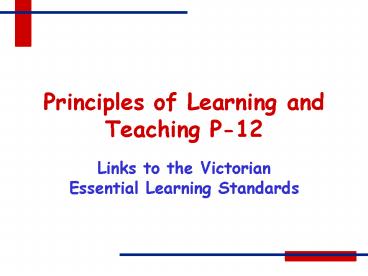Principles of Learning and Teaching P12 - PowerPoint PPT Presentation
1 / 16
Title:
Principles of Learning and Teaching P12
Description:
People construct new knowledge and understanding based on what they already know ... The quality of student-teacher relationships ... – PowerPoint PPT presentation
Number of Views:357
Avg rating:3.0/5.0
Title: Principles of Learning and Teaching P12
1
Principles of Learning and Teaching P-12
- Links to the Victorian Essential Learning
Standards
2
Activity
- What is pedagogy?
- On the post-it notes provided, write down your
definition of what pedagogy means to you - Share your ideas with a group and decide on one
definition for the group - Report back to the whole group
3
Some definitions of pedagogy
- A term that is used to describe an approach to
schooling, learning, and teaching that includes
what is taught, how teaching occurs, and how what
is taught is learned. academic.son.wisc.edu/dieke
lmann/research/definitions.htm - Literally means the art and science of educating
children, pedagogy is often used as a synonym for
teaching. Pedagogy embodies teacher-focused
education. www.neiu.edu/dbehrlic/hrd408/glossary
.htm
4
How People Learn (1)
- People construct new knowledge and understanding
based on what they already know and believe - Therefore.
- Students come to the classroom with
preconceptions about how the world works. If
their initial understanding is not engaged, they
may fail to grasp the new concepts and
information that are taught, or they may learn
them for purposes of a test but revert to their
preconceptions outside the classroom. - Bransford et al (2000) How People Learn
National Research Council. - Research eLert Issue 1, February 2005
- .
5
How People Learn (2)
- One of the hallmarks of the new science of
learning is its emphasis on learning with
understanding. - Understanding is the ability to use
ideas/information flexibly and appropriately in
novel contexts. To think and act flexibly with
what one knows. Requires a performance
capability.
6
Therefore
- To develop competence in an area of inquiry,
students must - Have a deep foundation of factual knowledge
- Understand facts and ideas in the context of a
conceptual framework - Organise knowledge in ways that assist retrieval
and application
7
Therefore.
- A metacognitive approach can help students
learn to take control of their own learning by
defining learning goals and monitoring their
progress in achieving them.
8
Implications for teaching
- Teachers must draw out and work with the
pre-existing understandings that their students
bring with them. - Teachers must teach some subject matter in depth,
providing many examples in which the same concept
is at work and providing a firm foundation of
factual knowledge. - The teaching of metacognitive skills should be
integrated into the curriculum in a variety of
subject areas.
9
Other factors that influence learning
- The quality of student-teacher relationships
- Cultural differences may influence background
knowledge and learning preferences. - The level of motivation and engagement
- The level and effectiveness of feedback that is
provided - The learning context level of connectedness
10
The Principles of Learning and Teaching P-12
- Students learn best when
- 1. The learning environment is supportive and
productive - 2. The learning environment promotes
independence, interdependence and self motivation
- 3. Students needs, backgrounds, perspectives and
interests are reflected in the learning program - 4. Students are challenged and supported to
develop deep levels of thinking and application - 5. Assessment practices are an integral part of
teaching and learning - 6. Learning connects strongly with communities
and practice beyond the classroom
11
Components
- The learning environment is supportive and
productive. - In learning environments that reflect this
principle the teacher - 1.1 builds positive relationships through
knowing - and valuing each student
- 1.2 promotes a culture of value and respect
for - individuals and their communities
- 1.3 uses strategies that promote students
self- - confidence and willingness to take
risks with their - learning
- 1.4 ensures each student experiences success
through - structured support, the valuing of
effort and - recognition of their work.
12
Activity
- Read the unpacking document for your assigned
Principle - As a group prepare either a concept/mind map of
the key points - Nominate a spokesperson/s for the group and share
ideas with the whole group
13
Victorian Essential Learning Standards
- Three Educational Purposes are embedded within
the three core strands of The Standards. - Students will need to create a future which
- Is sustainable
- Is innovative
- Builds strong communities.
14
Victorian Essential Learning Standards
- Five educational principles underpin The
Standards - Learning for all
- Pursuit of excellence
- Engagement and effort
- Respect for evidence
- Openness of mind
15
Activity
- Read over the Educational Purpose, Educational
Principles and Stages of Learning statements of
The Standards Overview document and Assessment
Principles. - .
- As a group, relate your assigned Principle of
Learning and Teaching P-12 (PoLT) to the
Purpose Statements, Educational Principles
and Stages of Learning for the Victorian
Essential Learning Standards. - .
- Where are the links between the PoLT and the
Standards? How does your Principle of Learning
and Teaching support the Standards? - .
- Justify how they relate/do not relate
- Identify 2 note worthy points. Why are they
- noteworthy?
- .
- Report back to whole group.
16
Activity
- Where to from here?
- Force Field Analysis
- What are the driving forces that will assist the
implementation of the Standards? - What are the restraining forces that will impede
the implementation of The Standards? - What are the de-activating forces that will
enable you to overcome the restraining forces? - Share your tables reflections with whole group































